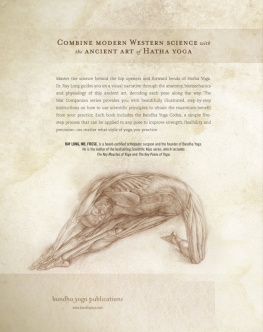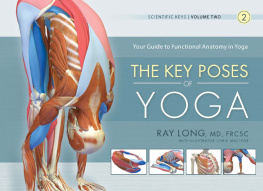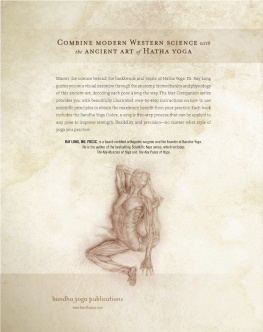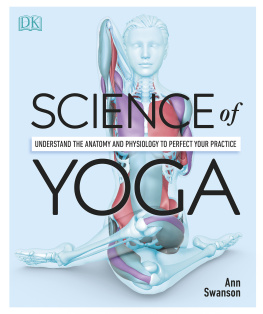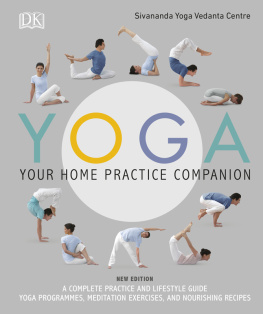
bandha yoga publications
This book is intended as a reference volume only, not as a medical manual. It is not to be used in any manner for diagnosis or treatment of medical or surgical conditions. This book is also not intended to be a substitute for any treatment that may be or has been prescribed by your health care provider. If you suspect that you have a medical problem, consult your physician. Always, in your particular case, obtain medical clearance from your physician before beginning the practice of yoga or any other exercise program. Always practice yoga under the direct guidance and supervision of a qualified and experienced instructor. Working directly with a qualified yoga instructor can help to prevent injuries. The author, illustrators, editor, publisher and distributor specifically disclaim any responsibility or liability for injuries that may occur during the practice of yoga or any other exercise program.
Published by Bandha Yoga Publications
Plattsburgh, NY
www.bandhayoga.com
Copyright 2010 Raymond A. Long, MD, FRCSC
All content, visual and textual, produced under the direction of Ray A. Long, MD, FRCSC
All rights reserved.
No part of this book may be reproduced, stored in a retrieval system, or transmitted by any means, electronic, mechanical, photocopying, recording, or otherwise, without written permission from the publisher.
Mat Companion is a registered trademark.
Distributed by Greenleaf Book Group LLC
For ordering information and bulk purchases, contact Bandha Yoga Publications.
Phone: 518.578.3720
Design and composition by Greenleaf Book Group LLC
Cover design by Greenleaf Book Group LLC
Front and back cover illustrations by Kurt Long, BFA www.kurtlong.net
Computer Graphics Technical Director: Chris Macivor
Sanskrit calligraphy and border painting: Stewart Thomas www.palmstone.com Editor: Eryn Kirkwood, MA, RYT www.barrhavenyoga.com
ISBN 13: 978-1-60743-945-5
Part of the Tree Neutral program, which offsets the number of trees consumed in the production and printing of this book by taking proactive steps, such as planting trees in direct proportion to the number of trees used: www.treeneutral.com
Printed in Canada on acid-free paper
10 11 12 13 14 15 10 9 8 7 6 5 4 3 2 1
First Edition

CONTENTS
INTRODUCTION
THE MAT COMPANION SERIES PROVIDES A METHODICAL APPROACH FOR USING science to balance and connect the body and mind in yoga. The fourth book concludes the series with arm balances and inversionstwo pose categories that clearly integrate opposites within the body.
In our bipedal form, the hips and lower extremities are the weight-bearing construct. The more mobile shoulders and upper extremities allow us to interact with the world. In arm balances, we invert this construct, thereby strengthening the muscles, bones, and ligaments of the upper extremities. From an energetic perspective, arm balances stimulate the nerve plexuses associated with the fourth and fifth chakras. Practicing these poses with precision moves nerve impulses upwards through the subtle body. This opens the way for the unimpeded flow of energy from the lower and more primordial regions of the sacral plexus to the higher-functioning levels of the brain.
A similar balancing of opposites takes place with inverted poses. Consider that most of our time is spent with the head above the heart and the lower extremities below it. Inversions reverse this, bringing the head below the heart and the lower extremities above it. Potential benefits of this body position include lowered blood pressure and heart rate and improved circulation of endorphins in the brain. All of this prepares the body for deep relaxation.
Arm balances invigorate and stimulate the mind. Inversions bring it to rest.
HOW TO USE THIS BOOK
Practicing yoga is like passing through a series of doors, with each door revealing new possibilities in the poses. The key to unlocking the first door is understanding the joint positions. This understanding can be used to identify the muscles that create the form of the pose and those that stretch. The key to positioning the joints is engaging the correct muscles. This begins with the prime movers. Engage the prime movers and the bones will align. The key to deepening the asanas is using your understanding of physiology to lengthen the muscles that stretch in the pose. Focus on these keys and the postures will automatically fall into place and manifest the beneficial effects of yoga. These include improved flexibility, heightened awareness, a sense of well-being, and deep relaxation.
The Mat Companion series is a set of modular books. Each book focuses on a specific pose category and contains the following:
- The Key Concepts: a description of biomechanical and physiological principles with applications for specific poses.
- The Bandha Yoga Codex: a simple five-step process that can be used to improve your flexibility, strength, and precision in the asanas.
- The Pose Section: a detailed description of the individual postures.
- Movement Index: explanations of body movement and tables listing the muscles associated with each movement.
- Anatomy Index: a visual listing of bones, ligaments, and muscles (showing the origins, insertions, and actions of each).
- Glossary of Terms
- Sanskrit Pronunciation and Pose Index
- English Pose Index

FIGURE 1 The Key Concepts show you how to apply biomechanics and physiology to your poses. Read this section first and return here often to refresh your knowledge.

FIGURE 2 The opening page for each pose illustrates the basic joint actions and positions of the body for that particular asana. Sanskrit and English names are provided for each posture. Use this page to assist you in learning the basic form of the pose and other concise details.
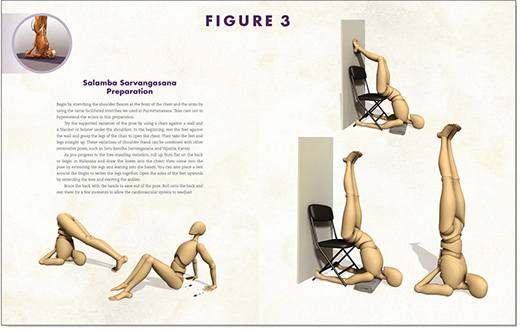
FIGURE 3 Use the preparatory section as a guide for how to enter the pose. If you are new to yoga or feel a bit stiff, use one of these modifications for your practice. In general, the preparatory poses affect the same muscle groups as the final asana. You will benefit from the pose no matter which variation you practice.
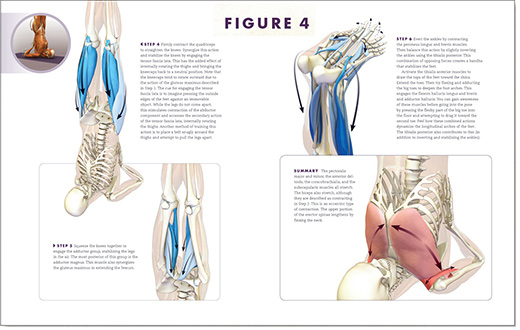
FIGURE 4 Each pose comes with a series of steps for engaging the muscles that position the joints, concluding with a summary of the muscles that stretch. Muscles that contract are colored different shades of blue (with the prime movers deep blue), and those that stretch are red. Use the pose section to master the anatomy of any given asana.
EVERY POSE TELLS A STORY
Paintings, sculptures, and yoga poseslike written works or cinemaall tell a story. With this in mind, it is helpful to look at the elements that create a narrative and see how they can be used to benefit your practice. Central to any story is a conflict that must be reconciled or an obstacle that must be overcome. Tension builds, and a crescendo is reached, followed by denouement. A solution must be negotiated. In the best stories, this dynamic evokes a cognitive shift in the audience, a new perspective. Consider this in the context of a pose or practice session. Use the metaphor of narrative structure to deepen the transformative power of yoga.
Next page

